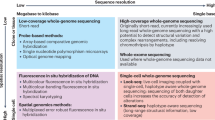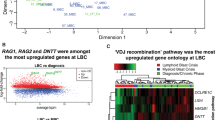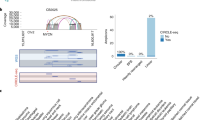Abstract
Changes in gene dosage are a major driver of cancer, known to be caused by a finite, but increasingly well annotated, repertoire of mutational mechanisms1. This can potentially generate correlated copy-number alterations across hundreds of linked genes, as exemplified by the 2% of childhood acute lymphoblastic leukaemia (ALL) with recurrent amplification of megabase regions of chromosome 21 (iAMP21)2,3. We used genomic, cytogenetic and transcriptional analysis, coupled with novel bioinformatic approaches, to reconstruct the evolution of iAMP21 ALL. Here we show that individuals born with the rare constitutional Robertsonian translocation between chromosomes 15 and 21, rob(15;21)(q10;q10)c, have approximately 2,700-fold increased risk of developing iAMP21 ALL compared to the general population. In such cases, amplification is initiated by a chromothripsis event involving both sister chromatids of the Robertsonian chromosome, a novel mechanism for cancer predisposition. In sporadic iAMP21, breakage-fusion-bridge cycles are typically the initiating event, often followed by chromothripsis. In both sporadic and rob(15;21)c-associated iAMP21, the final stages frequently involve duplications of the entire abnormal chromosome. The end-product is a derivative of chromosome 21 or the rob(15;21)c chromosome with gene dosage optimized for leukaemic potential, showing constrained copy-number levels over multiple linked genes. Thus, dicentric chromosomes may be an important precipitant of chromothripsis, as we show rob(15;21)c to be constitutionally dicentric and breakage-fusion-bridge cycles generate dicentric chromosomes somatically. Furthermore, our data illustrate that several cancer-specific mutational processes, applied sequentially, can coordinate to fashion copy-number profiles over large genomic scales, incrementally refining the fitness benefits of aggregated gene dosage changes.
This is a preview of subscription content, access via your institution
Access options
Subscribe to this journal
Receive 51 print issues and online access
$199.00 per year
only $3.90 per issue
Buy this article
- Purchase on Springer Link
- Instant access to full article PDF
Prices may be subject to local taxes which are calculated during checkout




Similar content being viewed by others
Accession codes
Data deposits
Genome sequence data have been deposited at the European Genome-Phenome Archive (http://www.ebi.ac.uk/ega/, hosted by the EBI) with accession number EGAD00001000658 (https://www.ebi.ac.uk/ega/datasets/EGAD00001000658).
References
Stratton, M. R., Campbell, P. J. & Futreal, P. A. The cancer genome. Nature 458, 719–724 (2009)
Rand, V. et al. Genomic characterization implicates iAMP21 as a likely primary genetic event in childhood B-cell precursor acute lymphoblastic leukemia. Blood 117, 6848–6855 (2011)
Strefford, J. C. et al. Complex genomic alterations and gene expression in acute lymphoblastic leukemia with intrachromosomal amplification of chromosome 21. Proc. Natl Acad. Sci. USA 103, 8167–8172 (2006)
Stiller, C. A., Kroll, M. E., Boyle, P. J. & Feng, Z. Population mixing, socioeconomic status and incidence of childhood acute lymphoblastic leukaemia in England and Wales: analysis by census ward. Br. J. Cancer 98, 1006–1011 (2008)
Moorman, A. V. et al. Prognosis of children with acute lymphoblastic leukemia (ALL) and intrachromosomal amplification of chromosome 21 (iAMP21). Blood 109, 2327–2330 (2007)
Moorman, A. V. et al. Risk-directed treatment intensification significantly reduces the risk of relapse among children and adolescents with acute lymphoblastic leukemia and intrachromosomal amplification of chromosome 21: a comparison of the MRC ALL97/99 and UKALL2003 trials. J. Clin. Oncol. 31, 3389–3396 (2013)
Heerema, N. A. et al. Intrachromosomal amplification of chromosome 21 is associated with inferior outcomes in children with acute lymphoblastic leukemia treated in contemporary standard-risk children's oncology group studies: a report from the children's oncology group. J. Clin. Oncol. 31, 3397–3402 (2013)
Hamerton, J. L., Canning, N., Ray, M. & Smith, S. A cytogenetic survey of 14,069 newborn infants. I. Incidence of chromosome abnormalities. Clin. Genet. 8, 223–243 (1975)
Jacobs, P. A., Browne, C., Gregson, N., Joyce, C. & White, H. Estimates of the frequency of chromosome abnormalities detectable in unselected newborns using moderate levels of banding. J. Med. Genet. 29, 103–108 (1992)
Campbell, P. J. et al. Identification of somatically acquired rearrangements in cancer using genome-wide massively parallel paired-end sequencing. Nature Genet. 40, 722–729 (2008)
Campbell, P. J. et al. The patterns and dynamics of genomic instability in metastatic pancreatic cancer. Nature 467, 1109–1113 (2010)
Sinclair, P. B. et al. Analysis of a breakpoint cluster reveals insight into the mechanism of intrachromosomal amplification in a lymphoid malignancy. Hum. Mol. Genet. 20, 2591–2602 (2011)
Robinson, H. M., Harrison, C. J., Moorman, A. V., Chudoba, I. & Strefford, J. C. Intrachromosomal amplification of chromosome 21 (iAMP21) may arise from a breakage-fusion-bridge cycle. Genes Chromosom. Cancer 46, 318–326 (2007)
Korbel, J. O. & Campbell, P. J. Criteria for inference of chromothripsis in cancer genomes. Cell 152, 1226–1236 (2013)
Rausch, T. et al. Genome sequencing of pediatric medulloblastoma links catastrophic DNA rearrangements with TP53 mutations. Cell 148, 59–71 (2012)
Stephens, P. J. et al. Massive genomic rearrangement acquired in a single catastrophic event during cancer development. Cell 144, 27–40 (2011)
Crasta, K. et al. DNA breaks and chromosome pulverization from errors in mitosis. Nature 482, 53–58 (2012)
Hatch, E. M., Fischer, A. H., Deerinck, T. J. & Hetzer, M. W. Catastrophic nuclear envelope collapse in cancer cell micronuclei. Cell 154, 47–60 (2013)
Beroukhim, R. et al. The landscape of somatic copy-number alteration across human cancers. Nature 463, 899–905 (2010)
Kim, T. M. et al. Functional genomic analysis of chromosomal aberrations in a compendium of 8000 cancer genomes. Genome Res. 23, 217–227 (2013)
Greenman, C. D. et al. Estimation of rearrangement phylogeny for cancer genomes. Genome Res. 22, 346–361 (2012)
Acknowledgements
We thank member laboratories of the United Kingdom Cancer Cytogenetic Group (UKCCG) for providing cytogenetic data and material. Primary childhood leukaemia samples used in this study were provided by the Leukaemia and Lymphoma Research Childhood Leukaemia Cell Bank working with the laboratory teams in the Bristol Genetics Laboratory, Southmead Hospital, Bristol, UK; Molecular Biology Laboratory, Royal Hospital for Sick Children, Glasgow, UK; Molecular Haematology Laboratory, Royal London Hospital, London, UK; Molecular Genetics Service and Sheffield Children’s Hospital, Sheffield, UK. We also thank all the members of the NCRI Childhood Cancer and Leukaemia Group (CCLG) Leukaemia Subgroup for access to material and data on clinical trial patients. This work was supported by the Wellcome Trust (077012/Z/05/Z); Leukaemia and Lymphoma Research Specialist Programme and European Research Council (249891). P.J.C. has a Wellcome Trust Senior Clinical Research Fellowship (WT088340MA). P.V.L. is supported by a postdoctoral research fellowship and P.V. is a Senior Clinical Investigator funded by the Research Foundation – Flanders (F.W.O.). P.S. is funded by the European Research Council (grant 249891).
Author information
Authors and Affiliations
Contributions
C.J.H. and P.J.C. designed the study; Y.L. carried out and interpreted the sequencing and associated analysis, assisted by E.P. and P.J.S.; C.S. and S.R. coordinated the study; C.S. carried out the FISH analyses and interpreted the FISH and SNP6.0 results; S.R. carried out the initial sequence analysis and associated validation; B.D.Y. assisted with the analysis of SNP6.0 data; C.S. and H.M.R. interpreted the cytogenetic findings; O.J., B.R., and M.M. performed laboratory analyses; P.J., M.G., P.T., N.B., N.T., C.H. and L.G. provided data on incidence of rob(15;21)c cases; P.J., F.M.R., N.A.H., A.J.C., N.B., N.T., M.R.T., S.D., J.B., N.D. and P.V. provided rob(15;21)c cases and associated clinical and genetic data to be included in the study; A.V.M. and R.J.Q.M. provided the incidence data and calculated the relative risk values; P.S. and V.R. provided data interpretation; J.C. and P.V.L. ran copy-number analyses and coordinated analysis of publicly available solid tumour cancer data; M.R.S. contributed to the analysis and interpretation of the sequencing studies. P.J.C. and C.J.H. assimilated the data and wrote the manuscript, with support from all authors.
Corresponding authors
Ethics declarations
Competing interests
The authors declare no competing financial interests.
Extended data figures and tables
Extended Data Figure 1 FISH studies of patient PD10009a indicating the role of the centromeres in the formation of the iAMP21 chromosome from rob(15;21)c patients.
a, A representative normal metaphase from a non-leukaemic cell hybridized with centromere specific probes for chromosomes 15 (CEP15, Cytocell) labelled green and chromosomes 13 and 21 (this probe cross hybridizes to both chromosomes 13 and 21, CEP13/21, Cytocell) labelled red. The chromosomes are counterstained with DAPI (blue). The discrete green signal indicates one copy of the normal chromosome 15, the two discrete red signals at the bottom of the cell indicate the two normal copies of chromosomes 13 and the discrete red signal at the top indicates the normal chromosome 21. The closely apposed red green signals at the bottom of the cell are hybridized to the rob(15;21)c confirming that this chromosome is dicentric with intact copies of both centromeres. In order to maintain stability and normal segregation at mitosis, one centromere of a dicentric chromosome needs to be inactive. In Robertsonian translocations, chromosome 15 is most frequently inactivated. This is often depicted by decondensation of the chromatin, in contrast to tightly condensed chromatin of an active centromere. In some cells the chromosome 21 centromere of the rob(15;21)c appeared smaller (condensed) than the chromosome 15 centromere (decondensed). b, A representative normal metaphase indicating the chromosome 15 centromere (CEP 15, green) and a probe set designed to cover the common region of amplification of chromosome 21 (CRA); probes RP11-777J19, RP11-383L18 and RP11-773I18 (as previously described) were hybridized together and labelled red. The discrete green signal indicates the centromere on the normal chromosome 15, the discrete red signal indicates the CRA on the normal chromosome 21, whereas the red and green signals close together show the centromere of chromosome 15 and the CRA on the rob(15;21)c. c, e, The same representative abnormal metaphase hybridized with CEP15 (green) and CEP13/21 (red) as above. The discrete green signal indicates the intact chromosome 15 centromere on the normal chromosome 15. The three discrete red signals show the centromeres on the two normal chromosomes 13 located either side of the red signal on the normal chromosome 21. The iAMP21 chromosome, which we know to be composed of both chromosomes 15 and 21, as patient PD7170a (Fig. 2), and to be in the formation of a ring chromosome has one red signal indicating the presence of an intact chromosome 21 centromere, but absence of the green signal indicating loss of the chromosome 15 centromere, which is present in the normal cells as shown in a. This loss of chromosome 15 centromere from the der(15;21) is also confirmed by sequencing (Fig. 3b). In e, the metaphase shown in panel c has had colours inverted to confirm the origin of the chromosomes and indicate the ring formation of the iAMP21 chromosome (arrow). d, f, The same representative abnormal metaphase hybridized with CEP15 (green) and the probe set specific for the CRA (red) as above. The discrete green signal at the bottom indicates the intact chromosome 15 centromere on the normal chromosome 15. The discrete red signal (bottom left) shows one copy of the CRA on the normal chromosome 21. The iAMP21 chromosome has multiple red signals indicating multiple copies of the CRA interspersed throughout this abnormal ring chromosome. In f, the image shown in d is inverted to confirm the origin of the chromosomes and indicate the ring formation of the iAMP21 chromosome (arrow).
Extended Data Figure 2 Rearrangement orientations are distributed equally on chromosome 21 in iAMP21 patients.
Comparison of rearrangement orientations for rearrangements on chromosome 21 (leftmost 4 bars for each panel) against the rest of the genome (rightmost 4 bars for each panel) for the 9 patients sequenced. These show that the distribution was not statistically different from uniform for the chromosome 21 rearrangements (P values under x axis legend). For rearrangements in the rest of the genome, deletion-type rearrangements (TH, coloured red) predominated. Multinomial distribution statistical significances (raw P values, rounded to 4 decimals) for the null hypothesis of equal distribution between all orientation types are shown in the x axis labels.
Extended Data Figure 3 Rearrangement metrics used to describe rearranged sections of a genome.
a, b, Illustration of the process of compiling rearrangement metrics in a hypothetically rearranged chromosome (a) and summarization of these values into the rearrangement metrics representation used in this study (b). CN, copy number.
Extended Data Figure 4 Rearrangement metrics of 50 simulated chromosomes under two alternative sequences of two rearrangement events, two BFB cycles and chromothripsis.
In copy-number step-size distribution plot, every simulated instance is represented by a point at each of the 5 copy-number change-size value, showing the frequency of copy-number steps with each copy-number step size. In copy-number jump-size distribution, rearrangements from all 50 simulated chromosomes are aggregated. In copy-number trajectory, every connected line represents a single simulated chromosome.
Extended Data Figure 5 Comparison of rearrangement metrics of two alternative sequences of rearrangements that generate a chromothripsis-like copy-number pattern involving three copy-number states.
In copy-number step-size distribution plot, every simulated instance is represented by a point at each of the five copy-number change-size value, showing the frequency of copy-number steps with each copy-number step size. In copy-number jump-size distribution, rearrangements from all 50 simulated chromosomes are aggregated. In copy-number trajectory, every connected line represents a single simulated chromosome.
Extended Data Figure 6 Copy-number and rearrangement pattern in the iAMP21 chromosome of patient PD9022a.
a, Copy-number and rearrangement pattern of PD9022a chromosome 21. D, deletion type rearrangement link; TD, tandem duplication type; TT, tail-to-tail rearrangement; HH, head-to-head rearrangement. b, the deletion type (tail-to-head) rearrangement resolved by five unmapped split reads whose mates mapped to the vicinity of the associated copy-number breakpoint. The mapped mates and unmapped split reads are joined together by dashed lines. The 5 split reads are aligned to the two ends of the rearrangement.
Extended Data Figure 7 Fold-back-like rearrangements of patient PD7170a.
a–c, Three fold-back-like rearrangement of the der(15;21) chromosome of patient PD7170a are shown (arrows). In a, the rearrangement is tail-to-tail type. In b and c, the rearrangement is head-to-head type.
Extended Data Figure 8 Formation of fold-back-like rearrangements.
If two copies of the same chromosome are rearranged in the same event, fold-back-like rearrangements may form (left). If two copies of the same chromosome undergo separate rearrangements, fold-back-like rearrangements cannot form.
Supplementary information
41586_2014_BFnature13115_MOESM54_ESM.pdf
This file contains Supplementary Results, Supplementary Methods, Supplementary Figures 1-30, Supplementary Tables 1-6 and Supplementary References. (PDF 7803 kb)
Rights and permissions
About this article
Cite this article
Li, Y., Schwab, C., Ryan, S. et al. Constitutional and somatic rearrangement of chromosome 21 in acute lymphoblastic leukaemia. Nature 508, 98–102 (2014). https://doi.org/10.1038/nature13115
Received:
Accepted:
Published:
Issue Date:
DOI: https://doi.org/10.1038/nature13115
This article is cited by
-
Whole genome sequencing provides comprehensive genetic testing in childhood B-cell acute lymphoblastic leukaemia
Leukemia (2023)
-
The complex karyotype in hematological malignancies: a comprehensive overview by the Francophone Group of Hematological Cytogenetics (GFCH)
Leukemia (2022)
-
The genomic landscape of pediatric acute lymphoblastic leukemia
Nature Genetics (2022)
-
Therapy-related B-cell acute lymphoblastic leukemia in adults has unique genetic profile with frequent loss of TP53 and inferior outcome
Leukemia (2021)
-
Structural variant evolution after telomere crisis
Nature Communications (2021)
Comments
By submitting a comment you agree to abide by our Terms and Community Guidelines. If you find something abusive or that does not comply with our terms or guidelines please flag it as inappropriate.



